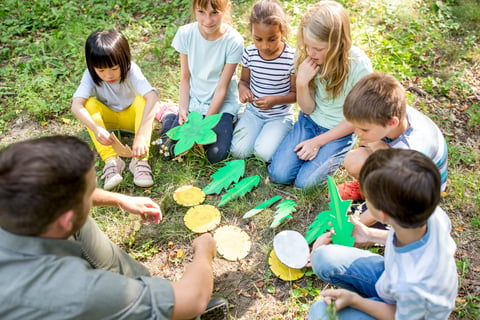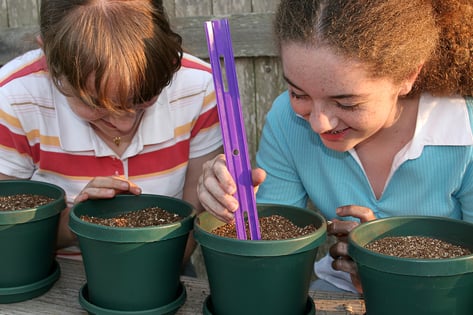
Math Assessment in California Schools: The Shift Toward Differentiated Instruction
Math assessment in California is changing. What used to be a compliance exercise or reporting tool is now becoming a...
ALI Staff | Published August 15, 2023
You might think STEM is all about computers and lab experiments, but science, technology, engineering, and math come alive in exciting ways when taken outside.
From guiding students in using their senses to experience nature to understanding the power of the sun, outdoor STEM activities help students connect classroom concepts to the real world. Being in nature sparks curiosity, boosts engagement, and makes learning more memorable. It’s also a refreshing change of pace for teachers, offering new ways to inspire and explore.
The best part is that outdoor STEM learning doesn’t have to be complicated. Many activities are simple, hands-on, perfect for all ages, and easy to integrate into your existing lessons. Research even shows that outdoor play enhances focus, creativity, physical health, and emotional well-being.
If you’re ready to take learning (and teaching!) outside, we’ve put together some tips, ideas, and example activities to make outdoor STEM a dynamic part of your teaching toolkit.

Teaching STEM outdoors offers exciting possibilities, but it can also feel overwhelming. Planning helps. It starts with choosing locations that are safe, accessible, and rich in natural features. That can be your school garden, a nearby park, or the playground. From there, stay flexible. Weather or unexpected scheduling conflicts can change your plans, so be ready to adapt.
We’ll get into some specifics (and fantastic outdoor activities for your youngest learners!) soon, but no matter the activity, build in time for reflection and discussion after. This ensures students connect what they did outdoors with STEM concepts they’ve learned in the classroom. It also keeps learning student-centered and inquiry-based.
Getting out of the classroom and into nature has proven academic and social-emotional benefits. Studies show that in addition to the physical and mental health boost, students feel more ownership over their learning and are more engaged when exposed to nature.
Outdoor STEM activities, in particular, help students apply concepts in meaningful ways, using real-world settings to build essential skills. Here’s what we’ve found as far as benefits to taking STEM outside:
Planning effective outdoor STEM activities starts with intentional choices that go beyond simply taking your lesson outside. To make the most of the natural environment, focus on choosing projects that support student inquiry, align with learning goals, and are practical for outdoor settings. Here’s some more detail:
A well-prepared outdoor space helps students focus, stay safe, and feel inspired to explore. Here are some tips:
A thoughtful structure in your lessons ensures that activities stay engaging, build on one another, and support deeper learning over time. Here are two important tips:
Outdoor play is the perfect opportunity to introduce STEM concepts to kindergartners. At this age, children are naturally curious, and simple questions like “Why do some things float?” or “What makes the wind blow?” can spark meaningful exploration. Nature offers endless opportunities to make science real and engaging.
Hands-on activities help children observe and describe the world around them. For example, they might sort materials like sand, soil, and pebbles, or collect leaves and discuss their shapes and textures. On windy days, they can watch how far leaves travel or tie ribbons to posts to see how they move, experiencing weather science firsthand. Outdoor math is just as easy. Try number-matching games with natural objects to reinforce counting and quantity recognition.
These playful, low-prep activities lay the foundation for scientific thinking and problem-solving. It also promotes social and collaborative skills and boosts student engagement. By taking STEM outside, young learners begin to see how science connects to everyday life, making learning more meaningful, memorable, and fun.

These hands-on projects encourage kids of all ages to explore STEM in real-world settings. Try these simple, engaging activities that encourage observation, experimentation, and problem-solving outside the classroom.
If you have access to a park or outdoor area, this is one of the easiest (but most engaging!) outdoor science activities. Simply take learners on a walk, stopping at different locations and asking them to use their five senses to observe and describe what they experience in nature.
If feasible, bring art supplies and use the stops as a chance for students to draw some of the things they observe. Suggest that they consider animals, plants, soil, clouds, terrain, water, and other aspects of the natural world.
Though not necessarily an outdoor activity, this cool STEM project is nature-themed and allows students to practice the scientific method. In this science activity, water vapor condenses into water droplets that attach to particles in the air within a Mason jar, creating a visible cloud.
For younger grades, this STEM activity can be paired with reading about weather and then observing, describing, and drawing clouds of different types outside. Older students can perform the experiment themselves and try two alternate variations as part of a unit on the water cycle or weather patterns.
Start inside with a lesson on leaf parts and then venture outdoors to identify leaf shapes for a nature-based STEM activity that encourages student exploration.
Younger learners might start with an art project where they create a set of paper leaf shapes on popsicle sticks that they can use to compare what they find outdoors. Older students might take photographs or sketches and create a poster demonstrating their labeled findings.
This could be a multi-day STEM project. Start with a discussion about soil structure, what lives in it, how much water it needs, and how to measure the amount of moisture in the soil. Students can then experiment with soil moisture and how this affects what grows in it for a hands-on outdoor STEM activity. Taking this one outside keeps mud out of your classroom, too!
Explore the sun's effects by inviting learners to observe how different natural and man-made materials and ground covers react to the sun and shade. Students can experiment with that idea by exposing paper cups filled with different types and colors of soil, water, and pebbles to sunlight, and observing or measuring how much heat they absorb.
This outdoor activity can be done outside on a windy day or inside using a table fan as a complement to a unit or scope on how and why plants disperse their seeds.
Students create different types of “seeds” using paper, paper clips, and other art supplies, then observe how well they travel when released into the wind. Set it up as a competition, as a controlled experiment, or even as a STEAM-style activity. As an extension activity or possible field trip, you can even pick a windy day to go fly kites!
While you’re working with wind, elementary-age students can create their own anemometers, or devices to measure wind speed and direction, using paper cups, straws, and a pencil.
This STEM project can start inside as a controlled experiment with a fan that runs at different speeds, and then move outside on different days and/or in different locations. It requires some flexibility, as you may want to take advantage of especially windy days.
Students can also be challenged to convert the speed of their anemometers to miles per hour using their math skills.
This STEM project involves creating a weather station over several outdoor sessions. After some foundational study of weather patterns, students build four simple tools to collect data on wind speed, air pressure, temperature, and precipitation.
They can then make their own weather predictions based on the science of weather. This one can be expanded into a semester-long project for older elementary students.
This is a hands-on outdoor STEM activity that builds teamwork and collaborative skills. Group your students into small teams and challenge them to build the largest tower they can using only string and sticks of different sizes.
In addition to the engineering challenge, this activity can include math skills by having them “purchase” their materials and measure the height of their final towers.
In this hands-on experiment, students observe the effects of filtration on polluted water. After creating polluted tubs of water using items in nature (or common trash!), they use tools like tongs, strainers, and coffee filters to send water through multiple filtrations.
The activity shows that while water may look cleaner, pollutants can still be present. It can also help students understand that polluting water is easy, but cleaning it is complex, and mimics the multi-step process real water treatment plants use.
On a nice, sunny day, take students outside with some sidewalk chalk and measuring tape to explore geometry by creating life-sized shapes on the pavement.
Working in pairs, they can draw shapes learned in the classroom, like triangles, rectangles, and circles. Older students can then measure the sides or radius and calculate the area and perimeter. It’s a more engaging way to compare/contrast, practice formulas, and reinforce concepts while encouraging teamwork and movement.
This DIY insect hotel project invites students to explore backyard biodiversity by building a simple bug house using natural materials like twigs, bark, leaves, and cardboard.
The activity encourages hands-on learning about ecosystems, as insect hotels provide shelter for beneficial bugs that help control pests and support garden health. It also highlights the importance of restoring habitats in urban areas, fostering environmental awareness.
Students build small aluminum foil boats of different sizes and test how much weight each can carry before sinking. By adding pennies and calculating the volume and mass, they explore the concept of density, or the relationship between mass and volume. This engaging experiment can help students understand why large steel ships float and how cargo affects buoyancy.
In this STEM activity, students build a parachute using tissue paper or a plastic bag and string, then test how it affects the fall of a small action figure. Have students bring in their favorites, with extras to share with those who may not have them at home.
By comparing drops with and without the parachute, they observe how air resistance, or drag, slows descent. The activity introduces basic physics concepts like gravity, force, and stability.
Guide students in creating a bird feeder using a recycled toilet paper roll, peanut butter, birdseed, and string, then hang feeders outside. This hands-on project promotes environmental awareness, encourages bird-watching, and teaches kids how to care for wildlife. This is a fun activity perfect for lessons on habitat or as a way to celebrate Earth Day.
This is a fun way to get the whole class involved in a lesson about composting. Students can bring in kitchen scraps like vegetable peels and add them to a container with soil and worms. (This can be prepped by the teacher or as a whole-class activity.) Worm bins can be kept outside in the shade, as long as they’re not exposed to freezing temperatures or heavy noise.
Over days or weeks, they observe how the worms break down organic matter into nutrient-rich compost. This teaches students about decomposition, ecosystems, and recycling natural waste. They can also observe worm behavior.
The classic baking soda and vinegar volcano is a fun, safe outdoor science experiment perfect for learners of all ages. By combining baking soda (a base) and vinegar (an acid) in a sandbox-built volcano, they create a fizzing eruption that models real volcanic activity.
This hands-on activity explores concepts like acids and bases, chemical reactions, and natural events. It’s easy to set up, keeps messes outside, and can be extended into a full science project using the scientific method.
Students create a miniature water cycle model inside a resealable plastic bag. By adding colored water, sand, and rocks to the bag and taping it to sunny and shaded spots, they can observe phenomena like evaporation, condensation, and runoff. This hands-on model helps explain how water moves through Earth’s atmosphere and surface in a visual way.
Guide students in building DIY sundials using paper plates, pencils, and markers. By placing the pencil upright in the center of the plate and marking the shadow’s position every hour, students observe how the sun’s movement across the sky changes the shadow’s angle.
This hands-on activity teaches about Earth’s rotation, timekeeping, and the relationship between the sun and shadows. It’s a great way to connect math and history, too, as you can link to lessons about how ancient cultures told time before clocks existed.
This activity invites students to dissect and explore parts of flowering plants, like roses or tulips. By carefully taking apart flowers and sorting stems, petals, stamens, or pistils, students learn about plant anatomy and pollination. The activity highlights the role of flowers in producing seeds and attracting pollinators in a hands-on way.

With a little creativity, nature STEM activities can be adapted to fit a variety of environments to make hands-on activities accessible to everyone. Here are some ideas to bring outdoor STEM experiences wherever you are:
By embracing flexible approaches and creative adaptations, outdoor STEM education can thrive in any space, inspiring learners to explore and discover the science all around them.
When students engage with nature through hands-on, outdoor STEM activities, they connect to the world around them in a deeper way. Encouraging outdoor exploration, observation, and experimentation builds critical thinking skills and nurtures creativity. By making the outdoors a meaningful part of learning, educators inspire students to become informed and thoughtful, with the bonus of academic, social-emotional, and engagement boosts.

Math assessment in California is changing. What used to be a compliance exercise or reporting tool is now becoming a...

You know the moment: a student’s eyes light up when the science experiment fizzes or the math puzzle helps them...

STEM classrooms are full of different types of learners in the classroom, each with their own strengths and needs.
...